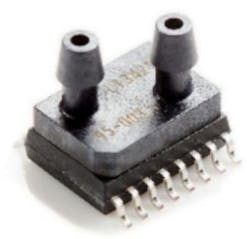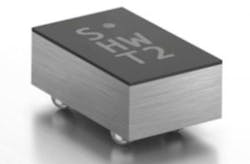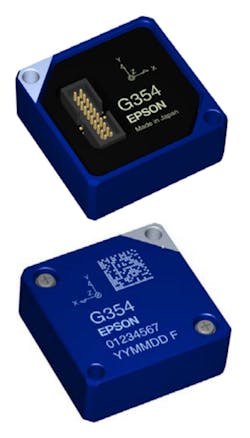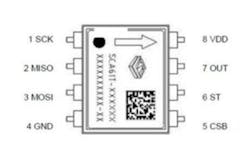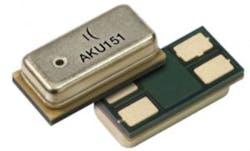Microelectromechanical systems (MEMS) represent a mature technology that recently has received renewed interest because of the growth in Internet-of-Things (IoT) activity. MEMS are segmented into microsensors, microactuators, and microstructures by the MEMS and Nanotechnology Exchange, “the world’s most diverse and comprehensive MEMS foundry” according to information on its website.
MEMS are found all around us—in inkjet printheads; microphones; automotive pressure sensors, air-bag accelerometers, tire-pressure monitors, and temperature sensors; and in large-screen displays that use steerable micromirror devices. In addition to standard products, many foundries manufacture custom components. The range of materials and techniques is large, allowing creation of very complex, specialized devices.
Tire pressure monitor
Since the early 1990s, tire pressure has been monitored by a sensor inside a tire and wirelessly transmitted to a receiver in the vehicle. The Model FXTH8715 high-pressure family of tire pressure monitoring sensors (TPMS) is highly integrated with a 7-mm x 7-mm footprint. It also provides an 8-mA transmitting current and a low-power wake-up feature for very long battery life.
The device includes an 8-kB memory, a Z-axis or a unique dual X- and Z-axis accelerometer, an 8-bit microcontroller, a pressure sensor, a temperature sensor, a two-channel timer, internal reference clocks, and a sub-1-GHz transmitter. TPMS are available with pressure ranges from 100 kPa to 1,500 kPa (approximately 14.5 psi to 218 psi) and in three grades:
standard and precision with ±20 kPa accuracy (±2.9 psi) and high precision with ±17 kPa (±2.5 psi). Freescale Semiconductor
Digital pressure sensor
Low pressures from 0.14 psi to 2.0 psi are accommodated by the SM9541 Series of RoHS- and REACH-compliant digital sensors. Combining a fully temperature-compensated pressure sensor with a CMOS mixed-signal-conditioning ASIC supports an I2C interface and eliminates the need for additional circuitry, such as a compensation network or a microcontroller containing a custom correction algorithm.
The 14-bit devices have an accuracy of ±1% of full scale over the -5°C to +65°C operating temperature range. All members of the series have two ports that are configured to make either differential or compound gage measurements. Gage pressure measurements are made with respect to atmospheric pressure, and a compound gage capability can cope with pressures above or below atmospheric. Alternatively, by selecting the appropriate model type, the two ports can be used to make differential pressure measurements.
Ultra-low pressure measurement is necessary in medical gas-flow applications such as sleep apnea machines, ventilators, and oxygenators. Industrial uses include pressure
switches, safety cabinets, and general gas-flow instrumentation. Silicon Microstructures
Humidity sensor
The SHTW2 is a digital humidity and temperature sensor in a 1.3-mm x 0.7-mm x 0.5-mm four-contact flip-chip package. Based on the manufacturer’s CMOSens technology, the complete single-chip sensor includes a capacitive humidity sensor, a bandgap temperature sensor, analog and digital signal processing, an A/D converter, calibration data memory, and a digital communications interface supporting I2C fast mode.
The sensor covers a relative humidity measurement range of 0% to 100% and a temperature measurement range of -30°C to +100°C with a typical accuracy of ±3% RH and ±0.4°C. The 1.8-V operating voltage and the low power consumption make the SHTW2 suitable for mobile or wireless applications. Typical measurement current drain is 385 µA, which corresponds to an average 8.6-µW power consumption if measurements are made once per second. Sensirion
Versatile accelerometer
The ADXL362 is an ultralow power, three-axis MEMS accelerometer suitable for use in hearing aids, home healthcare devices, wireless sensors, and motion-enabled equipment. It consumes less than 2 µA at a 100-Hz output data rate and only 270 nA when in the motion-triggered wake-up mode. Unlike accelerometers that use power duty-cycling to achieve low power consumption, the ADXL362 does not alias input signals by undersampling; it samples the full bandwidth of the sensor at all data rates and with 12-bit resolution. Eight-bit formatted data also is provided for more efficient single-byte transfers when a lower resolution is sufficient.
Measurement ranges of ±2g, ±4g, and ±8g are electrically selectable with a resolution of 1 mg/lsb on the ±2g range. For applications where a noise level lower than the normal 550 μg/√Hz is desired, either of two lower noise modes (down to 175 μg/√Hz typical) can be selected at minimal increase in supply current.
The ADXL362 includes a deep multimode output FIFO, a built-in micropower temperature sensor, and several activity detection modes such as adjustable threshold sleep and wake-up operation that can run as low as 270 nA at a 6-Hz (approximate) measurement rate. A pin output is provided to directly control an external switch when activity is detected. The device is available in a 3 mm × 3.25 mm × 1.06 mm package and operates on a wide 1.6-V to 3.5-V supply range. Analog Devices
Rugged inertial measurement unit
The M-G364 and M-G354 inertial measurement units (IMUs) are designed for demanding environments such as agriculture and construction. With three axes of gyroscopes and accelerometers, the new IMUs provide built-in support for both SPI and UART protocols. At 24 mm x 24 mm x 10 mm in size, the units offer 2.2 and 3.0 degree per hour gyro bias stability, respectively.
Typical applications for the new M-G364 and M-G354 IMUs include construction machine control, precision agriculture auto-steering, and unmanned vehicle guidance, all of which can generate high levels of vibration and shock that hinder MEMS IMU performance. The new units offer enhanced vibration and shock protection with a redesigned metal housing and internal architecture that isolate the inertial sensors while also facilitating top/bottom mounting via a high-reliability connector for easy integration.
Enhanced components inside the M-G364 and M-G354 IMUs also yield many benefits including increased long-term reliability, an expanded operating temperature range, improved sensor stability and resolution, and a 40% reduction in power consumption. Software features now provide delta angle/delta velocity output and an expanded selection of output data rates. Seiko Epson
Leveling with an inclinometer
The MEMS-based single-axis Series SCA61T inclinometers feature low temperature dependency, high resolution, and low noise together with robust sensing element design.
These characteristics support the use of the SCA61T for leveling instruments, platform leveling and stabilization, and acceleration and motion measurement. The inclinometers are insensitive to vibration due to their over-damped sensing elements and can withstand mechanical shocks of 20,000g.
The analog output uses a ratiometric design, which means that the zero offset point and sensitivity of the sensor are proportional to the supply voltage. However, when the same voltage is used for both the sensor and the A/D converter, the error caused by reference voltage variation is automatically compensated. A digital SPI interface provides control via several 8-bit commands as well as selectable temperature and inclination outputs.
The measuring range is ±30 degrees or ±90 degrees depending on the model. Resolution is 0.0025 degee, and the overdamped -3 dB bandwidth is 18 Hz. A robust self-test feature creates an electrostatic force that causes the proof-mass to deflect to the extreme positive position, simulating high acceleration. Because the test signal actually deflects the proof-mass, the entire signal path can be checked. Murata
Barometric pressure sensor
The DPS310 is a miniaturized digital barometric air pressure sensor with a range of 300 hPa to 1,200 hPa (about 4.35 psi to 17.4 psi) that also measures temperature from -40°C to +85°C. The pressure sensor element is based on a capacitive principle, which guarantees high precision during temperature changes. An internal signal processor converts the output from the pressure and temperature sensor elements to 24-bit results. Each pressure sensor has been individually calibrated and contains coefficients that are used to convert the measurement results to true pressure and temperature values.
To facilitate low-power consumption, the sensor has a 32-measurement FIFO that allows the host processor to remain in a sleep mode for a longer period between readouts. Sensor measurements and calibration coefficients are available via the serial I2C/SPI interface. Pressure and temperature measurement accuracies are ±0.06 hPa and ±0.5°C, respectively.
The small package and 3-µA current drain when making one measurement/s make the DPS310 ideal for mobile applications and wearable devices such as health and sports monitors. Infineon Technologies
Hearing for the mobile and wearable market
The AKU151 is a small, top-port, analog-output MEMS microphone. It consists of a MEMS acoustic sensor and an IC with a pre-amplifier, a charge pump, and supporting circuitry in a package measuring 3.42 mm x 1.70 mm x 0.93 mm.
Designed to provide high acoustic performance in a tiny top-port component, the microphone is ideal for space-constrained wearable accessories, IoT nodes, and smartphones that require good acoustic performance. The AKU151 offers a 65-dB signal-to-noise ratio, a flat frequency response, and uniform sensitivity matching of ±1dB between production parts. The metal lid package is immune to RFI and EMI, facilitating easy integration into wireless devices. Akustica

